what colour and pattern discription
Forums
I wonder if the foal and sire
I wonder if the foal and sire could be a case of patn1 and 2 on the same horse, fighting for the control. I'm pretty sure that there isn't really much of a question of the ability for a horse to have both types of patn, and for the foal to be blanket, one of the parents would have to have that type of patn, which the sire being a leopard, he may not, but the dam definitely doesn't because she would be a blanket and not varnish, so then we go back to the sire as the cause of the blanket on the foal.
I do see that the sire and the foal have similar smaller spots on the neck area, seems like the blanket patn is dominating there, but the leopard patn is making it more visible on the sire, but is dominating more on the foal.
Tell me if this sounds completely retarded, I just got home from a very bad night at work so I'm tired and rambling.
*with my basic understanding
*with my basic understanding on appy* I would say that the original mare would be classified as blanket, but may be carrying the leopard patn too, making her look more like a near leopard especially with the spots on her face and neck, but the more I think about it, it seems like appaloosa terms are similar to "overo" in the since that they may not be entirely accurate and are slightly vague; ie, the sire is a leopard yet had a blanket foal, meaning that he would more than likely be carrying both patn genes, and I personally think that is why his front half is rather small spotted compared to the back half. Also I think she looks more chestnut than silver bay, but app can really mute black.
The half brother looks silver bay imo, and his muzzle looks a little mottled, so in that case he is probably Lp too.
Actually, the current theory
Actually, the current theory is that Patn1 can cause a level of expression anywhere from 60% white to 100% white (nose-to-toes). I think this mare would fall in the 60% category and could be called a near-leopard. Horses with this level of expression are thought to be h/z for Patn1, which is a definite possibly for this mare. Dam is patn1/patn1 and sire is PATN1/?.
I never knew that ..so a 60%
I never knew that ..so a 60% horse should be able to produce a 100% foal
by the way the original mares dam was born bay , got snowflakes withiin months and has had no more progression since she was very young ( she 14 now) and the spotty sire has had that amount of spots all his life ( hes 10 now) but the spots themselves have faded slightly
A 60% horse absolutely can
A 60% horse absolutely can produce a 100% leopard -- I've seen it happen. I use leopard and fewspot stallions almost exclusively now, so I've seen every level of expression in the Patn1 continuum.
My fewspot stallion has sired a large number of near-leopards(60% - 80%)out of non-LP mares, which I think supports the theory that these lower-level horses are h/z for Patn1. Quite often they are mistaken for spotted blankets, and it certainly CAN be difficult to tell them apart. But if one of the parents is a leopard (as is the case with your mare) or fewspot, then the horse certainly has the potential to be a near-leopard.
I used to own a snowcap stallion and a 100% palomino leopard stallion (both deceased now). The spotted blanket foals sired by the snowcap had a different look to them than the near-leopard foals sired by the leopard -- even though the white pattern level on the blanket foals might actually be greater than on the near-leopards.
AppyLady, can you post some
AppyLady, can you post some examples of more minimal leopards and some blanket apps of about the same white so I can see the difference?
So are you saying that the dam of the foal is patn/patn? If so, then she would have to be negative for Lp or else she would be patterned, but she is a snowflake, so I thought that would mean that she would have to be positive for lp, but negative for patn.
Also, on top of the 60-100% leopard, is it still dominant over blanket (as far as we know)? and patn zygosity doesn't matter as far as fewspot/snowcap, right? I thought it was only Lp had to be h/z, and thats why a lot of fewspot/snowcap horses can throw non-patterned foals, but they generally end up varnishing from the lp.
-Just trying to get this app stuff straight in my head.
OK, jumped to the end as I am
OK, jumped to the end as I am cold and tired, so sorry if repeated. Not going into technicalities as I can't and it is all still educated theory anyway.
The mare already is a near Leopard- a foal born with one patch of white on it's bum can go Near Leopard- just can't go Leopard- although it can mimic it pretty well.
How far does the blanket have to extend before it is called a Near Leopard??
I call this colt a extended Blanket.
[img]http://www.shadowplayminihorses.co.uk/1…]
At the moment, anyway, as I have NO idea where this pattern is going. His dam is black with one roan splash on her face, her dam was full Leopard - looking- was actually near Leopard as she was born black.
His sire is a Fewspot, so we do not know what, apart form chestnut, is hiding under there, his sire's dam was a similar but "murkier" (yes, I know, very technical) pattern to himself, his sires sire was Leopard (although I would have called him a near leopard.
He may be an extended blanket, but you will note the total lack of spots on his neck, even though he was clipped in this picture (quite a while ago)No varnish on his neck, either.
He is completely different to your mare.
DC
[img]http://www.shadowplayminihorses.co.uk/g…]
I think will end up near Leopard. He looks a lot more like your mare and has the same dark spots all over his neck which are unaffected by the "roaning out" that is going on there.
The dam gets her snowflakes
The dam gets her snowflakes from Lp -- no help needed from any pattern genes! It's Lp itself that's responsible for characteristics -- white sclera, mottled skin, striped hooves, and a progressive sort of roaning (varnish roan and/or snowflakes).
In my opinion, the difference between an extended blanket and a near-leopard is one of genotype rather than phenotype. A near-leopard is a lower expression of the Patn1 gene, whereas the extended blanket is a higher expression of the blanket genes (probably a large number of pattern modifiers, which added together can produce a very large blanket). A horse with an extended blanket can produce offspring with blankets of all sizes, but will never produce a full leopard or near-leopard on its own. A near-leopard has the Patn1 gene, and therefore CAN produce leopards and near-leopards. Near-leopard bred to near-leopard will often produce a full blown nose-to-toes 100% leopard.
Personally, I don't think it's written in stone that a near-leopard has to roan out to reveal spots underneath. Most do, but not all.
I'm looking for some pictures to show the difference between a true blanket pattern and a low expression near-leopard.
supaspot60 wrote:I never knew
[quote=supaspot60]I never knew that ..so a 60% horse should be able to produce a 100% foal
by the way the original mares dam was born bay , got snowflakes withiin months and has had no more progression since she was very young ( she 14 now) and the spotty sire has had that amount of spots all his life ( hes 10 now) but the spots themselves have faded slightly[/quote]
It would depend on what suppression factors were present in the parent that weren't present in the foal.
The OP horse shows where her
The OP horse shows where her blanket was and where roaning has shown up the "other" spots. The OP horse did NOT generate the leopard, but the other way around...the OP horse is by the leopard out of the snowflake mare. Since the snowflake mare has little/no Patn, the Patn gene had to come from the leopard, which again goes back to what I said...Patn-1 is dominant to the other Patns, and will express itself.
Rabbit, I would call your colt an extended blanket, which would indicate that dad is likely also an extended blanket but with suppression going on in him caused by his blackness, whereas the colt is free of that, being chestnut.
Diane
This morning the Appaloosa
This morning the Appaloosa Project was comparing pictures of leopard fillies that were thought to be PATN1/PATN1, and those thought to be PATN1/patn1. I don't think cross-posting is allowed, but the pictures were interesting. The H/Z leopards were nose-to-toes (or mostly so) and the h/z leopards were what we would call near-leopards, and showed various levels of expression. I'm sure a lot of people would call them extended blankets. It was mentioned that Patn1 has a wide range of expression, and we really don't know what the bottom end is.
Here are a couple fillies that I raised:
[img]http://img.photobucket.com/albums/v150/…]
[img]http://img.photobucket.com/albums/v150/…]
The palomino filly was sired by a smoky black snowcap stallion, and out of a near-leopard mare. Her blanket is about half the size of her sire, which is to be expected since he would only pass on half of his pattern modifiers. She obviously did not inherit Patn1 from her dam. Her blanket has distinct edges, and the spots are medium sized and spaced a good distance apart.
The buckskin filly SHOULD have been a leopard (or near-leopard). Her sire was a full nose-to-toes palomino leopard thought to be PATN1/PATN1, and her dam was a fewspot. All of her full siblings were fewspots or leopards. I fully expected this filly to roan out to be a near-leopard -- at the very least, she should have had the ribbing on her sides and spotted patches on her shoulders. That didn't happen. Her blanket never got much bigger than what you see here, and she didn't develop any more spotting. It's my theory that she is PATN1/patn1, with a highly suppressed pattern. Her blanket has roany edges, and the spots are small and close together -- the "shrunken sweater effect". If suppressors hadn't been present, her blanket most likely would have stretched up to her shoulders.
I realize most people would call the buckskin a spotted blanket. That's what I call her myself, since visually, that's what she is. But genetically, I'd be willing to bet that she is in fact, a near-leopard!
NZ Appaloosas wrote:Oh, and
[quote=NZ Appaloosas]Oh, and she's a blanket with varnish roaning...she'll never "be" a near-leopard, or even a full one; she'd have to have been born with those patterns to be one.[/quote]
the op mare is def a blanket then because she was born with a tiny blanket
Thought this was interesting!
Thought this was interesting! Just this morning the Appaloosa Project posted photos of a bay filly with a spotted blanket about the size of the buckskin filly I posted above -- and she is believed to be PATN1/patn1. So I may not be very far off the mark with mine!
I also have a bay mare with a spotted blanket, and I'm pretty sure she's actually PATN1/patn1 -- another highly suppressed leopard. I'll sure be happy when a test for Patn1 is available!
Yep, I think so too. Minis,
Yep, I think so too. Minis, especially, have a knack for suppressing appaloosa patterns. I remember one mini that was discussed by the AP that had even less white at birth than the OP mare. She, too, roaned out to be a near-leopard. The AP was pretty sure she was Patn1.
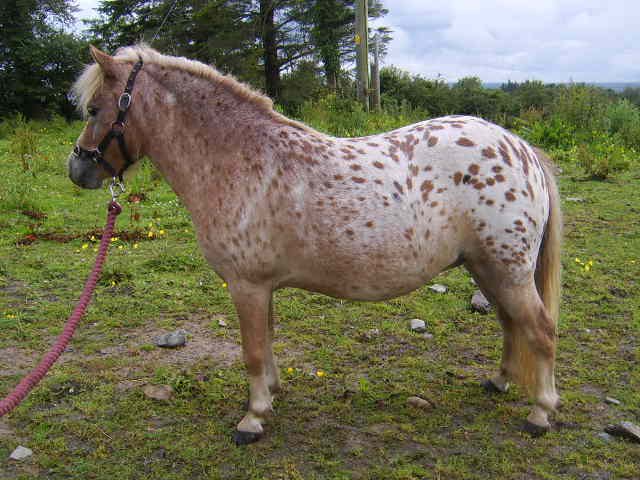

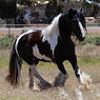
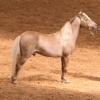
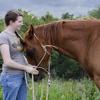
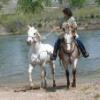
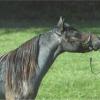
You got Lp there...Lp can
You got Lp there...Lp can cause dark hairs to turn white, even on colour. Casey had white eyelashes on dark eyelids.